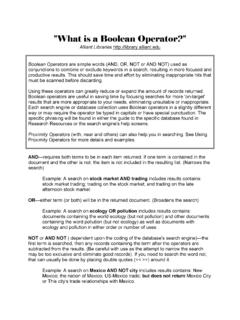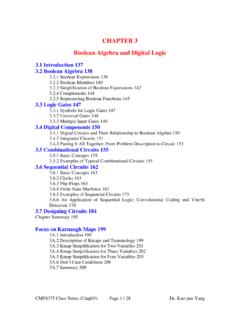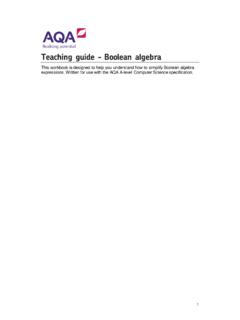Transcription of If Statements and Booleans - Stanford University
1 CS106A, StanfordHandout #32 Fall, 2004-05 Nick ParlanteIf Statements and BooleansFor a program to do anything interesting, it needs if- Statements and Booleans to controlwhich bits of code to execute. Here is a simple (temperature > 100) { ("Dang, it's hot!");}The simplest if-statement has two parts a boolean "test" within parentheses ( ) followedby "body" block of Statements within curly braces { }. The test can be any expression thatevaluates to a boolean value true or false value ( boolean expressions are detailedbelow). The if-statement evaluates the test and then runs the body code only if the test istrue. If the test is false, the body is common form of if-statement adds an "else" clause such as with the code belowwhich prints one message or the (temperature > 100) { ("Too darn hot");}else { ("At least it's not more than 100");}The if/else form is handy for either-or logic, where we want to choose one of twopossible if/else is like a fork in the road.
2 Under the control of the boolean test, one or theother will be taken, but not both. For example, the famous Robert Frost poem is a thinlydisguised comment on the importance of the if/else roads diverged in a wood, and I -I took the one less traveled by,And that has made all the Operators: <, <=, >, >=The easiest way to get a boolean value (true or false) is using a comparison expression,such as (a < 10). The less-than operator , <, takes two values and evaluates to true if thefirst is less than the second. So for example, the expression (var < 10) evaluates to thevalue true if var is less than 10, and false otherwise. The < is an " operator " just like + and* appearing between two values to compute something.
3 Instead of "var" and "10", thecomparison can use any int or double expressions, so for example we could write acomparison expression like (score > (highScore+100)). This comparison will2evaluate to true if the score value is greater than the (highScore+100) value, and willevaluate to false are four less-than type <less-than>greater-than<=less-or-equal ( )>=greater-or-equal ( )There is overlap between these, since we could use less-than to write something like(a<b), but that would work just the same as writing it with greater-than: (b>a). It makesno difference to the computer. We will prefer the version which reads most : 10<a<20It's tempting to write an expression like "10<a<20" to see if a is between 10 and 20.
4 Thatdoes not work. Each "<" operator must get its own two values. So the correct way towrite it is:(10<a && a<20).Equality Operators ==, !=The == operator tests if two values are exactly the same, so (a == b) is true if a and bhave exactly the same value. The not-equal operator , !=, is the opposite, evaluating totrue if the values are different. We use == and != only with primitives such as int, neverwith objects like String and Color. With objects, we use the message equals() to similarity of == and equals() can be confusing, so we use a simple rule: Every valuein Java is either a primitive or an object. We use ==, <, >=, with primitives like intand double. We use equals() with objects like String and Color.
5 Since the dereference dot(.) only works with objects, you can remember it this way: if it can take a dot then useequals() ( a String), otherwise use == ( an int).Doubles vs. ==The one addition to this rule is that we never use == or != with doubles, since the intrinsiclittle error term on every double value throws off the operation of ==. For example,summing up 1/10, 100 times may not exactly == To compare two doubles, subtractone from the other, and then see if the difference is very suppose we have doubles d1 and d2// We use the () standard method that computes// absolute value// check if d1 and d2 are essentially equal// (if the absolute value of their difference is less// than 1e-6 ( )if ( (d1 - d2) <= 1e-6) {.)}
6 3 boolean TypeThe simplest and most common form of boolean expression is the use a < in an if-statement as shown above. However, boolean is a full primitive type in Java, just like intand double. In the boolean type, there are only two possible values: true and false. Wecan have variables and expressions of type boolean , just has we have variables andexpressions of type int and double. A boolean variable is only capable of storing eitherthe value true or the value false. The words true and false are built-in literals in Java thatcan be used right in the code. As with other types, Java checks the code to make sure thatthe right type of value goes into each i = 6;// okboolean a = false;// okboolean b = "hello";// NO, String and boolean are differentboolean c = "false";// NO, "false" in quotes is a String!
7 String s = "false";// okBoolean OperatorsJust as we have + and * operators that work on int values, we have operators that work onboolean values. Suppose we have boolean expressions b1 and b2, which may be simpleboolean variables, or may be boolean expressions such as (score < 100). The "and" operator && takes two boolean values and evaluates to true if both are true. The "or" operator || (two vertical bars) takes two boolean values and evaluates to true if one or theother or both are we have int variables score and temperature, the code below prints "It's hot outand so am I" if the score is 10 or more and temperature is 100 or more. The && is trueonly if both of the two Booleans it connects are ( (score >= 10) && (temperature >= 100) ) { ("It's hot out, and so am I!)}
8 ");}Suppose we are in a bad mood if our score is less than 5 or the temperature is 32 ( (score < 5) || (temperature <= 32) ) { ("I'm in a bad mood");}Finally, the "not" operator ! (an exclamation mark) goes to the left of a booleanexpression and inverts it, changing true to false and false to we want to print something if it is not the case that the score is less than 5, wecould write that (!(score < 5)) { ("Score is 5 or more)");4}First, the expression (score < 5) evaluates to true or false, and then the ! inverts theboolean value. The result is that the body runs if the expression (score < 5) is false, whichis to say it runs if (score >= 5) is true. (We could equivalently write the if-statement with(score >= 5), but the point was to demonstrate the !
9 Restaurant ExampleSuppose we want to get a table at a hip restaurant, but we are afraid that the Maitre'd isgoing to say something rude instead of seating us. The variable "style" represents thestylishness of our outfits and the variable "bribe" represents the bribe presented to theMaitre'd. The Maitre'd is satisfied if style is 8 or more and bribe is 5 or more. TheMatire'd says "Je n'think so" if they are not satisfied. One way to code this up is to writethe "satisfied" expression as a straight translation of the problem statement, and then puta ! in front of Say something mean if not satisfiedif (! ((style>=8) && (bribe>=5)) ) { ("Je n'think so");}With combinations of !, <, >=, etc.
10 There can be a few different ways to code whatamounts to the same thing. As a matter of style, we prefer the code that reads mostnaturally to express the goal of the example, the following is equivalent to the above, although I find it near impossibleto Say something mean if not satisfiedif (!(!(style<8) && !(bribe<5))) {Here is another equivalent form, which is not so Say something mean if not satisfiedif ((style<8) || (bribe<5)) {Java also has "bitwise" operators & and | (which we are not using) which are differentfrom && and ||. If your boolean code will not compile, make sure you did notaccidentally type a bitwise operator (&) instead of a boolean operator (&&). boolean PrecedenceThe above examples used parentheses to spell out the order of operations.}}
















